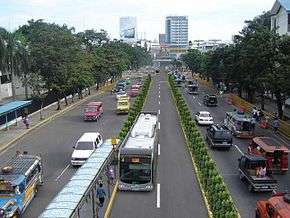Osmeña Boulevard
Osmeña Boulevard is a major arterial thoroughfare in Cebu City, Philippines. It is the city's "main street" which travels in a generally northwest–southeast orientation linking the old downtown district of San Roque near the harbor with the modern uptown Capitol Site district. Beginning at M.J. Cuenco Avenue in the east, the boulevard heads northwest towards Fuente Osmeña circle and ends at Escario Street. At its north end, the Cebu Provincial Capitol serves as a prominent terminating vista. It is the location of many of Cebu's notable institutions such as the Cebu Normal University, Abellana National School and Cebu Doctors' University Hospital; the Basilica of Santo Niño; one of the city's tallest buildings, Crown Regency Hotel; and shopping centers Robinsons Place Cebu and Gaisano Colon.
| |
|---|---|
| Jones Avenue | |
 Osmeña Boulevard, with the artist's impression of Cebu Bus Rapid Transit System in its middle. | |
| Route information | |
| Length | 3.2 km (2.0 mi) |
| Component highways | |
| Major junctions | |
| From | Cuenco Avenue in San Roque |
| Colon Street N. Bacalso Avenue Gen. Maxilom (Mango) Avenue | |
| To | Escario Street in Capitol Site |
| Location | |
| Major cities | Cebu City |
| Highway system | |
| |
History
Osmeña Boulevard was developed during the American period to connect the old Spanish colonial town of Cebu to outlying areas being opened up by the American government as its new city.[1] It was formerly named Jones Avenue, after U.S. Congressman William Atkinson Jones who sponsored the bill known as Jones Law or Philippine Autonomy Law of 1916. It was renamed "Doña Pepang Avenue" on March 29, 1960 by virtue of City Ordinance No. 284.[2] in honor of Sergio Osmeña's wife Estefania Veloso Osmeña since the spouses owned a mansion and estate along the boulevard. Then an ordinance in 1978 reinforced a change to the present Osmeña Boulevard.
Route description

Osmeña Boulevard begins as a four-lane undivided road at the intersection with M.J. Cuenco Avenue near Fort San Pedro in Plaza Independencia, San Roque area. The road goes for 0.8 kilometers (0.5 miles) west through Pari-an and Kalubihan passing narrow streets and the Basilica of Santo Niño until it turns north at Colon Street, the city's old shopping district. At Sanciangko Street just past the University of Cebu main campus, the boulevard divides slightly and becomes three lanes each way. It intersects with N. Bacalso Avenue and traverses Santa Cruz and Sambag passing Cebu Normal University and Abellana National School. Also in the vicinity of N. Bacalso and Pantaleon del Rosario Street are the University of San Carlos and Cebu City Sports Complex. The boulevard continues north towards Fuente Osmeña circle, a large roundabout with a park and fountain in the middle, where many hotels are located such as Crown Regency, Cebu Midtown Hotel and Rajah Park Hotel. Fuente Osmeña is also the location of Robinsons Place Cebu and Robinsons Cybergate shopping malls. The road ends right in front of the Cebu Provincial Capitol which creates a terminating vista for those looking north along the boulevard. Escario Street leads east towards Camputhaw and the Cebu Business Park. Towards the west, the boulevard connects to M. Velez Street, which leads towards Barangay Guadalupe, the largest barangay of Cebu City.
References
- Giving Cebu back its Main Street published by the Philippine Daily Inquirer; accessed 2013-12-12.
- The then Doña Pepang Avenue of Cebu City published by the Philippine Star; accessed 2013-12-12.
.svg.png)